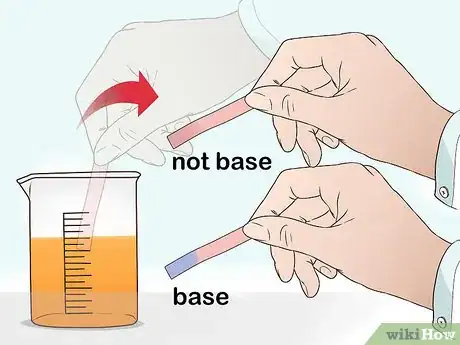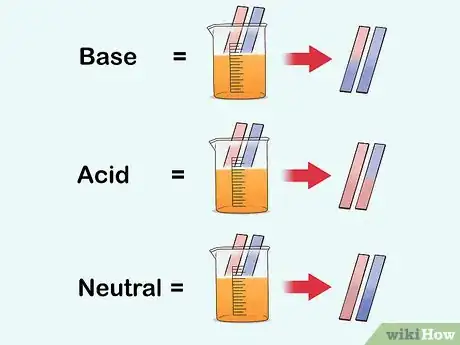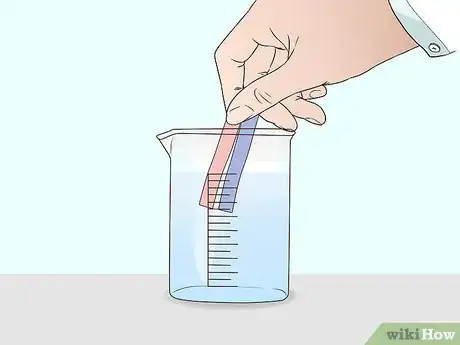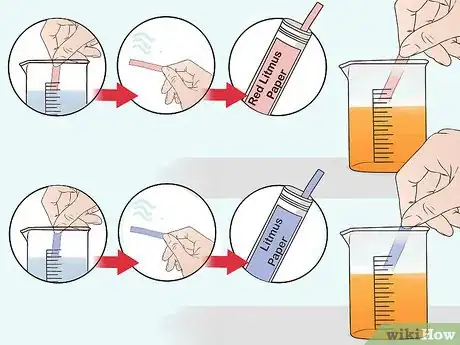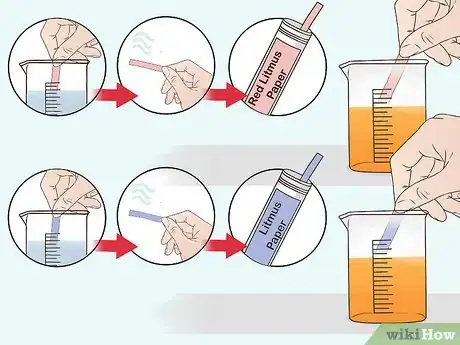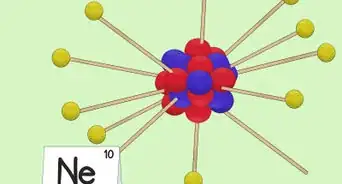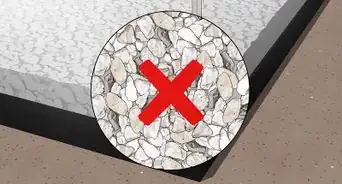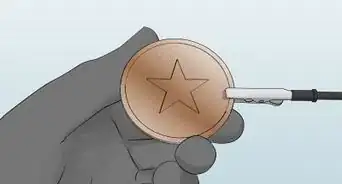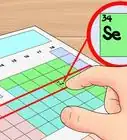This article was co-authored by Bess Ruff, MA. Bess Ruff is a Geography PhD student at Florida State University. She received her MA in Environmental Science and Management from the University of California, Santa Barbara in 2016. She has conducted survey work for marine spatial planning projects in the Caribbean and provided research support as a graduate fellow for the Sustainable Fisheries Group.
This article has been viewed 41,649 times.
Performing a litmus test is one of the oldest and simplest methods of determining the acidity or alkalinity of a solution. Litmus paper is made when a piece of thin paper is coated by organic dyes that are sensitive to changes in pH. When the dye is exposed to a liquid or gas, it will either react or stay the same based on the pH of the sample. If the dye reacts, its color will change. Keep in mind that litmus paper only works with samples dissolved in water.
Steps
Dipping Litmus Paper in Liquid
-
1Pour an aqueous sample. Pour some of your sample from its original container into a glass or beaker. This way, you will not contaminate the rest of the sample by dipping the litmus paper. Make sure that the sample you choose is aqueous (dissolved in water), otherwise the litmus test will not work.[1]
- For example, orange juice is comprised primarily of water. A litmus test will be effective in this case.
- Another liquid, vegetable oil, is not aqueous. Thus, the litmus test will not yield any results.
-
2Test for alkalinity. Dip a piece of red litmus paper into the liquid. If the paper turns blue, your liquid is a base (pH > 7). If the paper stays red, your liquid is not a base.[2]
- Ruling out a base does not definitively tell you that the liquid is an acid (pH < 7). It could also be neutral (pH = 7).
Advertisement -
3Test for acidity. Dip a piece of blue litmus paper into the liquid. If the paper turns red, the liquid is an acid. If the paper remains blue, the liquid is either a base or is neutral.[3]
-
4Analyze both papers. By using both tests, you can determine if the liquid is an acid, a base, or neutral. To do this, you have to analyze how each paper reacted to the liquid. For example:
- Base - Red paper turns blue. Blue paper does not change.
- Acid - Red paper does not change. Blue paper turns red.
- Neutral - Red paper does not change. Blue paper does not change.
Exposing Litmus Paper to Gas
-
1Wet 2 pieces of litmus paper. A litmus test works best with gases that are dissolved in water (an aqueous solution). To achieve this on a small scale, you only need to wet the paper with water. When the gas touches the wet paper, some of it will dissolve into solution right on the test strip.[4]
-
2Place the papers in contact with the gas. You should do this part under a fume hood. Open the container of gas and allow some of it to come in contact with both red and blue litmus paper. Use all appropriate safety precautions for the gases you are testing.[5]
-
3Analyze the results. The papers react to gases in the same way that they react to liquids, except that the gas reacts more evenly across the entire surface of the paper. Record the color changes of each paper. Use the data to determine if the gas is an acid, a base, or neutral.[6]
- Base - Red paper turns blue. Blue paper does not change.
- Acid - Blue paper turns red. Red paper does not change.
- Neutral - Red paper does not change. Blue paper does not change.
Reusing Litmus Paper
-
1Allow the litmus paper to dry. Once you have used the litmus paper, it will be wet. Before it can be reused, you should allow the paper to dry. Set it out at room temperature for a few hours, and then you should be able to store it as dry litmus paper.
-
2Reuse unchanged litmus paper. If the paper was unchanged by the reaction, it can be reused as the same color. This means that red litmus paper would remain red litmus paper, and blue litmus paper would remain blue litmus paper. You can store them in their respective tubes until the next use.
-
3Reuse changed litmus paper as the new color. If your paper came in contact with a sample and changed colors, you can now use it as the color that it has become. Red litmus paper that turned blue can be reused as blue litmus paper. Blue litmus paper that turned red can be reused as red litmus paper.
Community Q&A
-
QuestionHow do I reuse yellow litmus paper?
 Community AnswerYou shouldn't reuse litmus paper as the reaction would have already been completed and it would be difficult to reverse it. If you're using strips of litmus, only use half of it each time to save paper.
Community AnswerYou shouldn't reuse litmus paper as the reaction would have already been completed and it would be difficult to reverse it. If you're using strips of litmus, only use half of it each time to save paper.
Warnings
- Some gases are poisonous if inhaled. You should test pH under a fume hood.⧼thumbs_response⧽
- Some gases are corrosive to the skin and eyes. You should wear a goggles and gloves when handling corrosive gases.⧼thumbs_response⧽
References
- ↑ https://chem.libretexts.org/Courses/SUNY_Oneonta/Chem_221%3A_Organic_Chemistry_I_(Bennett)/2%3ALab_Textbook_(Nichols)/06%3A_Miscellaneous_Techniques/6.04%3A_Chemical_Tests/6.4D%3A_Individual_Tests
- ↑ https://sciencing.com/common-acid-base-indicators-8375206.html
- ↑ https://sciencing.com/common-acid-base-indicators-8375206.html
- ↑ https://www.bbc.co.uk/bitesize/guides/zcxmfcw/revision/3
- ↑ https://www.bbc.co.uk/bitesize/guides/zcxmfcw/revision/3
- ↑ https://www.bbc.co.uk/bitesize/guides/zcxmfcw/revision/3

